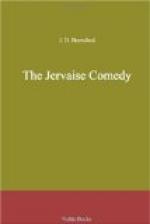A woman’s life, her thoughts, sensations and emotions directly presented, without artificial narrative or analysis, without autobiography.
The main interest lies in Mary Olivier’s search for Reality, her relations with her mother, father and three brothers, and her final passage from the bondage of infancy, the conflicts of childhood and adolescence, the disenchantments (and other drawbacks) of maturity, to the freedom, peace and happiness of middle-age.
The period covered is from 1865 when Mary is two years old to 1910 when she is forty-seven.
* * * * *
EDEN PHILLPOTTS’ NEW NOVEL
Storm in a Teacup
BY EDEN PHILLPOTTS
Author of “The Spinners,” “Old Delabole,” “Brunel’s Towers,” etc.
Cloth, 12mo.
This carries on Mr. Phillpotts’ series of novels dealing with the human side of the different industries. Here the art of paper making furnishes the background. The theme is somewhat humorous in nature. A young wife picks a quarrel with her husband because he is commonplace, and elopes with a man of high intellectual ability. Finding him, however, extremely prosaic and a bore, she is glad in the end to return to her first love.
The elopement, it might be explained, was purely a nominal one, carried out on a high moral basis with the most tender respect for the lady’s reputation and character. This fact leads to a number of unusual and frequently amusing situations.
* * * * *
From Father to Son
BY MARY S. WATTS
Author of “Nathan Burke,” “The Rise of Jennie Gushing,” “The Boardman Family,” etc.
Cloth, 12 mo.
The hero of Mrs. Watts’ new story is a young man belonging to a very wealthy family, who has had every sort of luxury and advantage and who, upon entering his father’s office after leaving college, finds that the huge fortune founded by his grandfather was mainly made by profiteering on the grandfather’s part during the Civil War. The question is what is this young man of the present day to do? He is high-minded and sensitive and the problem is a difficult one. What, too, is his own father to do—also a man of sterling character, though of a sterner type. The theme which grows out of this situation is one of singular interest and power and involves a moving crowd of characters.
Among these is the hero’s sister, who marries a German attache at the embassy in Washington; and another sister, who marries a young man of the same social set—and things happen. There is a drunken scalawag of a relative—who might be worse, and there are one or two other people whom readers of Mrs. Watts’ books have met before. The dates of the story are from 1911 to the present year.




